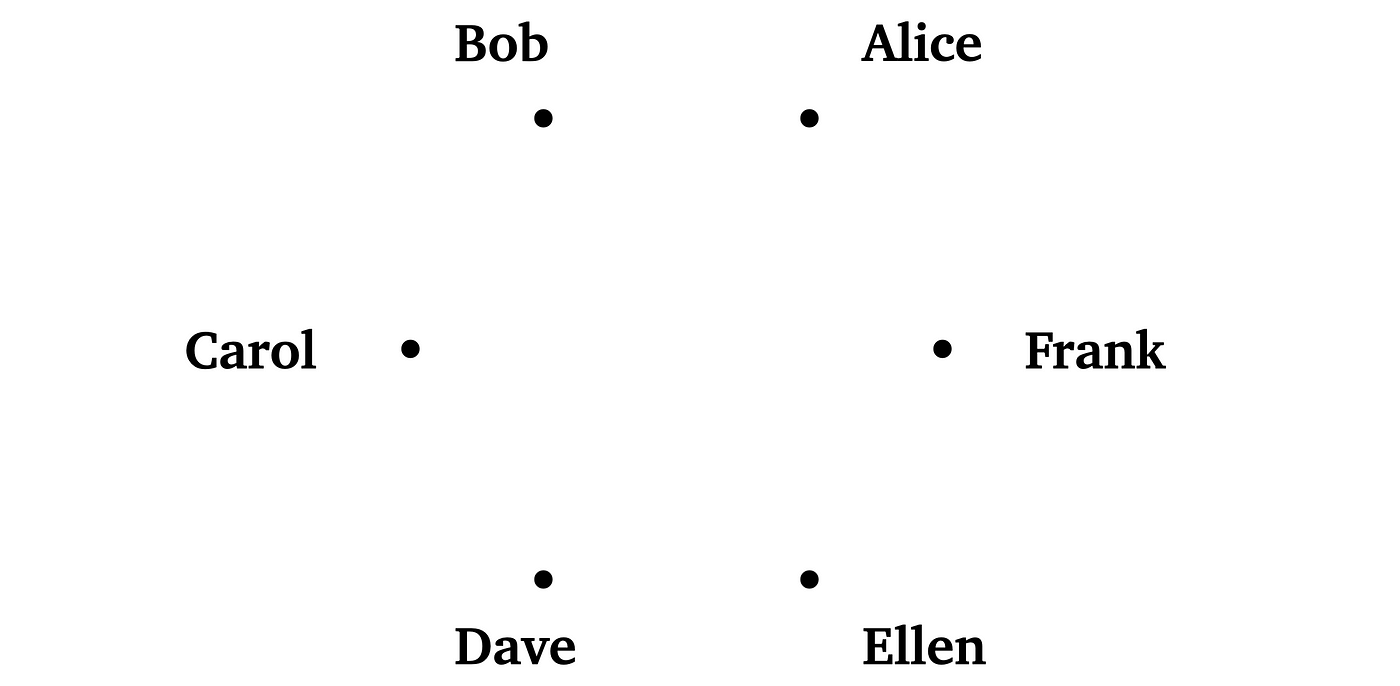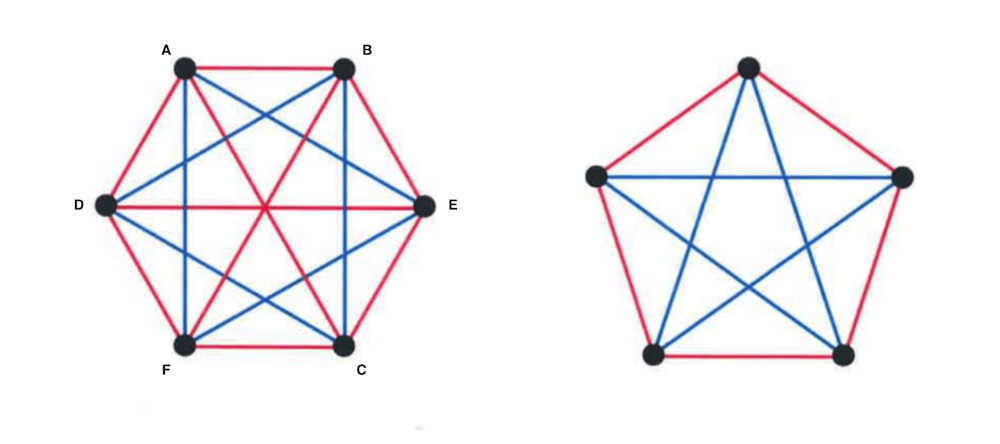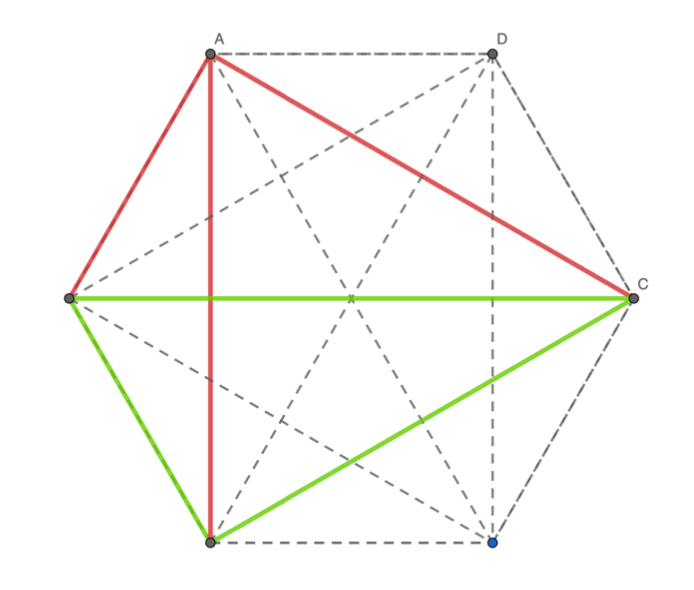Theorem on Friends and Strangers; Why in Any Party of Six People, Either at Least Three of Them Are Mutual Friends, or at Least Three of Them Are Mutual Strangers
Por um escritor misterioso
Last updated 20 setembro 2024

Let’s take a look at Alice first. To her, each one of the other five (Bob, Carol, Dave, Ellen, and Frank) is either a friend or a stranger. Suppose Bob, Dave, and Frank are friends to Alice, and…

This math puzzle will help you plan your next party

Theorem on Friends and Strangers. Ramsey Theory and Graham's Number, by Francesco Di Lallo
How to prove: at a party of six people either there are three mutual acquaintances or there are three mutual strangers - Quora

This math puzzle will help you plan your next party

Ramsey Theorems in Euclidean Geometry — Math In Action

Can Math Prove You'll Always Be the Odd One Out At Parties?, by Mary Paskhaver, Geek Culture

Friendship - Wikipedia

Ramsey Theory on Facebook - Scientific American Blog Network

The Friendship Theorem - You Always Have 3 Friends Or 3 Strangers At A Party

Party Problem The simplest example of Ramsey theory. It is also known as the 'Maximum Clique Problem'. A clique of a graph is a complete sub graph of the. - ppt download
Recomendado para você
-
 Strangers can become best friends just as easy best friends can become strangers.20 setembro 2024
Strangers can become best friends just as easy best friends can become strangers.20 setembro 2024 -
Stranger Friends20 setembro 2024
-
 Friends and Strangers (2021) - IMDb20 setembro 2024
Friends and Strangers (2021) - IMDb20 setembro 2024 -
 Quotes 'nd Notes - Strangers can become best friends just as easy as20 setembro 2024
Quotes 'nd Notes - Strangers can become best friends just as easy as20 setembro 2024 -
 How does a best friend become a complete stranger?20 setembro 2024
How does a best friend become a complete stranger?20 setembro 2024 -
 Drake Quote: “It's great when two strangers become best friends but not when best friends become20 setembro 2024
Drake Quote: “It's great when two strangers become best friends but not when best friends become20 setembro 2024 -
 Conversations on Love: Lovers, Strangers, Parents, Friends, Endings, Beginnings20 setembro 2024
Conversations on Love: Lovers, Strangers, Parents, Friends, Endings, Beginnings20 setembro 2024 -
 Strangers Can Become Best Friends Life lesson quotes, Stranger quotes, Lesson quotes20 setembro 2024
Strangers Can Become Best Friends Life lesson quotes, Stranger quotes, Lesson quotes20 setembro 2024 -
 Volunteering Solutions on X: Strangers are just friends waiting to happen. #Travel #Quotes #Quoteoftheday #tuesday / X20 setembro 2024
Volunteering Solutions on X: Strangers are just friends waiting to happen. #Travel #Quotes #Quoteoftheday #tuesday / X20 setembro 2024 -
 Friends And Strangers - C Instruments" Sheet Music for Lead Sheet - Sheet Music Now20 setembro 2024
Friends And Strangers - C Instruments" Sheet Music for Lead Sheet - Sheet Music Now20 setembro 2024
você pode gostar
-
 Wednesday Addams Font Free Download - Letroot20 setembro 2024
Wednesday Addams Font Free Download - Letroot20 setembro 2024 -
 Wolfenstein Franchise on Steam Deck is INCREDIBLE - 60 FPS Goodness? - The New Order - 2 and More!20 setembro 2024
Wolfenstein Franchise on Steam Deck is INCREDIBLE - 60 FPS Goodness? - The New Order - 2 and More!20 setembro 2024 -
 Head Soccer 2022 Jogue Head Soccer 2022 no20 setembro 2024
Head Soccer 2022 Jogue Head Soccer 2022 no20 setembro 2024 -
 “I think I made everybody..” -Creator [TAGS: #Doors #Gacha #Figure20 setembro 2024
“I think I made everybody..” -Creator [TAGS: #Doors #Gacha #Figure20 setembro 2024 -
 Minimalist phone wallpaper 4k - Rocket Space phone wallpaper, Phone wallpaper, Minimal wallpaper20 setembro 2024
Minimalist phone wallpaper 4k - Rocket Space phone wallpaper, Phone wallpaper, Minimal wallpaper20 setembro 2024 -
 London, UK. 30th June, 2020. QPR Manager Mark Warburton greets20 setembro 2024
London, UK. 30th June, 2020. QPR Manager Mark Warburton greets20 setembro 2024 -
 2023 New Garten Of Banban 2 3 4 Plush Game Animation Surrounding20 setembro 2024
2023 New Garten Of Banban 2 3 4 Plush Game Animation Surrounding20 setembro 2024 -
Free Fire Brasil updated their cover photo. - Free Fire Brasil20 setembro 2024
-
 Plants Vs. Zombies 2: It's About Time Plants Vs. Zombies: Garden20 setembro 2024
Plants Vs. Zombies 2: It's About Time Plants Vs. Zombies: Garden20 setembro 2024 -
 Toradora! -1 Utilis Inutilis20 setembro 2024
Toradora! -1 Utilis Inutilis20 setembro 2024

